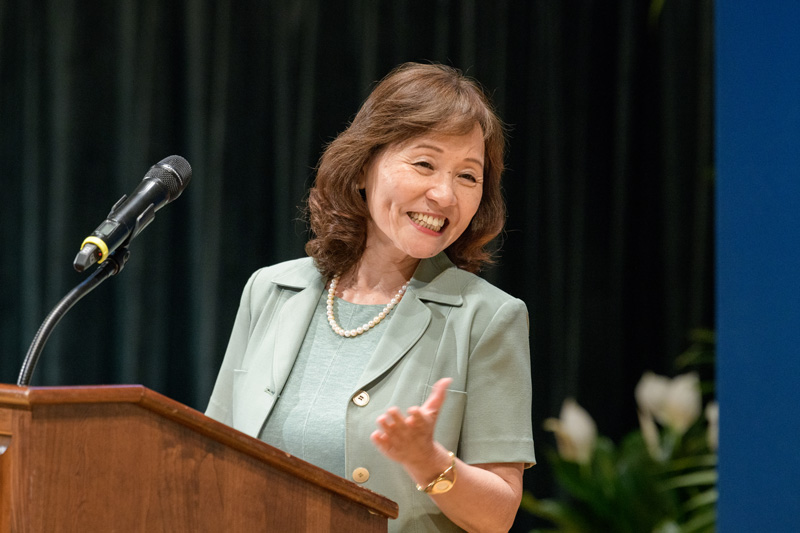Launch of Data Science Institute adds major collaborative muscle
The University of Delaware on Tuesday, Sept. 4, celebrated the addition of a powerful new muscle in its research enterprise, launching its Data Science Institute before a full house in Gore Recital Hall.
The new institute links faculty and students from all of UD’s seven colleges, including health sciences, physical sciences, environmental sciences, behavioral and social sciences and public policy. Partnerships with industry, government, military officials and other institutions also are in the works.
The value of data — the facts of the matter — cannot be overstated, especially in this age of questionable information. And data science is the power tool that helps researchers make sense of the world’s perpetual tsunami of numbers, measurements, graphics, statistics and all manner of experimental, theoretical and computational findings.

UD President Dennis Assanis speaks at the launch ceremony for the University’s Data Science Institute.
That kind of analysis leads to insights and knowledge that would otherwise be inaccessible.
“This is really a momentous day for the entire University of Delaware,” UD President Dennis Assanis said in the opening remarks at the launch. “One of the primary missions of a major research university like UD is to not only create knowledge in particular disciplines, but to be an intellectual intersection — a hub of discovery — that combines and amplifies the work of multiple disciplines.”
More than 125 faculty members already use the tools of data science in their fields of study, Assanis said. Many were part of the 2017 symposium and subsequent white paper that recommended a data-dedicated institute.
Assanis and Provost Robin Morgan earlier this year named a world-renowned data science expert as the founding director of the new institute — UD’s own Cathy Wu, who is the Unidel Edward G. Jefferson Chair in Engineering and Computer Science. Wu, one of the most highly cited researchers in her field, specializes in bioinformatics and computational biology and has been a pioneering force, developing international resources such as the Protein Information Resource and UniProt, as well as new ways to analyze biomedical data for disease and drug discovery.
She and her new and growing team of experts have much raw material to work with, and Assanis put some numbers to that.
“We have more information and more data points about our world than ever before,” he said. “Just a couple of years ago, global internet traffic hit 1 zettabyte per year — that’s a trillion gigabytes of data zooming around the global networks. By next year, we’ll double that amount. And a few years later, we’ll double it again.
“Cathy is going to ask Robin and me for a bigger computer.”
Already, she and search teams led by Doug Doren, interim vice provost for graduate and professional education, have added five researchers to the institute’s resident faculty, with more negotiations continuing. There were more than 300 applicants for the positions, Assanis said.
“We are thrilled with the interest we’re generating,” he said. “We don’t want to be just another player. We want to be a leader.”
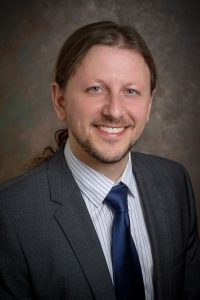
Gregory Dobler
The cluster hire, as that hiring surge is known, includes biomedical informatics expert Rahmat Beheshti, astrophysicist Federica Bianco, neural data expert Austin Brockmeier, astrophysicist/urban scientist Gregory Dobler and information theorist Xiugang Wu.
“These are all rising stars,” Wu said. “And they won’t be pigeon-holed. They will have the supportive environment and freedom to explore new opportunities and to shine.”
Those explorations already are under way.
Take Dobler, for example. For the past five years, he has applied his skills in astrophysics to new studies in urban science, developing a unique “Urban Observatory” system that uses hyperspectral cameras to survey New York City’s skyline and environs. He takes that data and does geospatial analysis, explores how lighting is used, for example, and looks at the interconnection of people, the natural environment and built environment to see if he could study a city’s system that way.
He plans to bring his Urban Observatory research to Delaware, testing the work he has established in New York in a smaller city environment. He has not yet decided where to focus that work here. But his collaborative work with New York City Audubon already has produced a collaborative link with UD’s Jeff Buler, associate professor of wildlife ecology, who has done extensive research on the effect of urban lighting on migratory birds.
Dobler said he was drawn by that kind of organic, connective energy.
“What’s happening here is very unique,” he said. “A lot of times you see a data science institute as they’re being formed — very top down. It’s more unique to see this work from the bottom up. Faculty members are saying they want to collaborate, work across colleges and put something together — and that draws on all of our expertise.
“It’s a building-from-scratch kind of thing and I’m excited to get my hands dirty, jump in there and build this thing.”
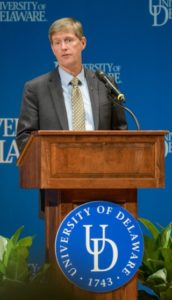
Charles G. Riordan, UD’s vice president for research, scholarship and innovation.
The burgeoning need for “data-savvy” workers continues to grow around the world, too. The McKinsey Global Institute predicts that 1.5 million more such workers will be needed by 2020.
“Access to information has become very flattened across this globe,” said Charles G. Riordan, UD’s vice president for research, scholarship and innovation. “If one has access to a computer or a smartphone and you’re sitting in a café in Mumbai or Seaford, Delaware, or anywhere else for that matter — we all have access to the same information. So the value of higher education is what skills are we imparting to students to help them leverage that information, take that information and derive value and problem solve.”
The work has great significance for government and military agencies and implications for the economic strength of the state.
An hour before Tuesday’s launch, James Collins, Delaware’s chief information officer who has worked with UD on cybersecurity matters, was present in a meeting as representatives of the U.S. Army’s Communications–Electronics Research, Development and Engineering Center (CERDEC) at Aberdeen Proving Ground signed a Joint Work Statement with UD’s Data Science Institute.
“This is the continuation of a 10-year journey,” said Chuck Hoppe, associate director of Science, Technology and Engineering for CERDEC. “The opening of the Data Science Institute here is just ripe for that relationship to continue…. It’s a diamond in the rough.”
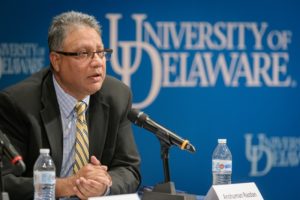
Anshuman “A.R.” Razdan, UD’s associate vice president for research development, moderated a panel discussion at the Data Science Institute launch.
UD’s new institute builds on the University’s considerable strengths in theoretical and computing “nodes of excellence” within the Department of Mathematical Sciences, the Department of Computer and Information Sciences, and the Department of Electrical and Computer Engineering. The University also is strong in biotechnology, bioinformatics and systems biology, environmental sciences, astronomy, policy, education, financial analytics and research ethics.
Its work will be guided by a faculty council, which includes data science leaders representing all seven colleges across the University.
“Everybody on this council are leaders and very busy people,” Wu said. “I am so heartened — everybody I asked said ‘Yes.’ And everyone is excited to be able to contribute to this initiative, with broad-based engagement in research, training, infrastructure and networking and external relations.”
A panel discussion Tuesday, moderated by Anshuman “A.R.” Razdan, associate vice president for research development, further demonstrated the breadth of UD’s data reach, with researchers speaking on their work and its potential impact in health sciences (John Jeka), mathematics (Lou Rossi), education (Henry May) and plant and soil sciences (Rodrigo Vargas). Also on that panel was Vicky Funanage, operational vice president for Nemours Biomedical Research in Nemours Children’s Health System, which works with more than 410,000 children each year.
In addition to Dobler, UDaily asked the other four new DSI resident faculty to comment on their work and the reason they were drawn to the new institute. Here are their answers:
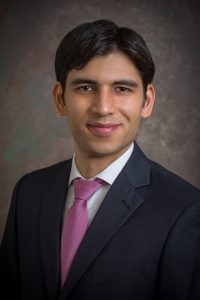
Rahmat Beheshti
Rahmat Beheshti
I work in the biomedical informatics field and specifically public health informatics. The most exciting and promising aspect of this area of research is the ability to work on some health problems that were almost untouchable before applying the new analytical methods that data science offers. For instance, the whole idea of “precision health (or medicine)” is only achievable by collecting and analyzing enough data for the individuals who are supposed to receive specific interventions based on their biological, social and environmental characteristics.
The Data Science Institute (DSI) is the result of a big and brave effort bringing researchers from traditionally distinct fields (like engineering and public health) to tackle larger problems that face our community and our world in the 21st century. Because of its “bridging” nature, it catalyzes the collaborations among the scholars from different colleges at UD.
I am hoping that DSI becomes a hub for major discoveries across a variety of fields of study at UD. Specifically, and as it relates to my area of work, I hope DSI can offer significant and meaningful solutions to reduce the burden of diseases by both preventing and treating those diseases.
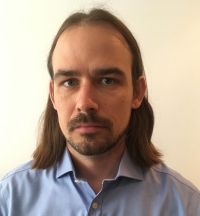
Austin Brockmeier
Austin Brockmeier
I am interested in approaches to gain insights from complex data. I’ve worked with neural signals from the brain, where the goal is to understand how the brain is representing different intentions and sensory stimuli. I’ve also been working on automatic methods for organizing large collections of scientific abstracts, which need to be searched for evidence-based research. For me the interesting part is connecting the real-world problem with the data and designing the algorithms and models to achieve this.
When I toured the campus, I was impressed by the support and enthusiasm across numerous colleges. Everyone had a data science story to share from their field. I think it will become a contact point for researchers, industry and other organizations. In terms of education, data science literacy is increasingly important. Both subject-specific and interdisciplinary courses are going to be in demand. This is an exciting time to be involved.

Federica Bianco
Federica Bianco
I work on interdisciplinary, multidisciplinary, data-driven science. My training is in astrophysics. I am currently involved in the development of the largest astrophysical survey ever attempted, the Large Synoptic Survey Telescope, which will image the whole Southern Hemisphere sky every three days, generating 30 terabytes of data every night, 1,000 images every night, discovering 10 million transients every night, astrophysical objects that changed in the sky, including exploding stars, merging black holes, planets transiting in front of their host star, asteroids. This is a giant leap forward in astronomy, a survey that will produce so much data to require sophisticated data science approaches to be analyzed and understood.
My scientific focus in this survey is the study of exploding stars, understanding which star exploded and why from the characteristics of the visible explosion, since the stars are too faint and too far to be seen before the explosion, and on the opportunity to discover rare, unknown objects and phenomena in the universe.
But really the thing that gets me most excited about the DSI is its interdisciplinary vocation. In addition to my astrophysics portfolio, I study a variety of data-driven problems in urban science and public policy, and my UD affiliations with the Physics Department and School for Public Policy and Administration reflect this.
I am passionate about bringing expertise in data analysis acquired in my astrophysics studies and research to the human dimension. My multidisciplinary projects include the study of energy consumption and of pollution produced by buildings in urban environments from imaging surveys of the cityscape, as well as studies in prosecutorial justice, urban health and collaboration with governmental agencies to understand and improve communication with the citizens.
The UD Data Science Institute was a grassroots movement. It was not a decision of the University heads to create one such institute, but rather the response to a need and an urgency felt by the UD faculty across departments and disciplines, to embrace data science and this is reflected in the engagement and enthusiasm of the faculty in this adventure. For me, it will enable me to maintain an interdisciplinary portfolio and allow me to find collaborations across disciplines, which is exceedingly, and very unfortunately, difficult in a standard academic environment. I hope it develops into a center where we all can learn from each other, lend our fresh eyes and borrow our colleagues’ to see problems in a new light and develop innovative solutions in data-driven science problems across fields and topics.
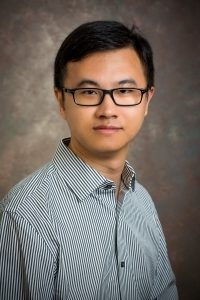
Xiugang Wu
Xiugang Wu
First, I’m broadly interested in information and data science, and I’m mainly concerned with questions such as how to efficiently communicate data and how to effectively infer and learn from data.
Since our world is becoming increasingly interconnected, I want to look at the above-mentioned questions, especially in the network scenario. For example, in the rapidly growing Internet-of-Things (IoT) applications, how to operate the wireless networks so as to provide the capacity needed for transporting big data? How to extract useful information from big data, particularly in a distributed fashion, when the data sets could be distributed over different places across the network? These questions are of paramount importance today and are most compelling in my opinion.
The most appealing part of the Data Science Institute here at UD lies in that it really creates an ideal environment for people from different disciplines — math, statistics, electrical engineering and computer science, etc. — to collaborate and solve big problems in the big data era.
I consider myself a person who has been mainly focused on the theoretical foundation of data science in the past and also who wants to explore more on practical applications of data science in the future. To further my research on the foundation side, I could really benefit from the discussions with people in math and statistics. In fact, one of my proudest works I have done previously is to use geometric tools to solve a three-decade open problem in information theory, and here at UD we do have world-renowned experts in geometry from the math department who can really help me to further my research in this line. On the other hand, to broaden my research on the application side, there are also a lot of people and resources I could draw on, especially in the ECE (Electrical and Computer Engineering) and CIS (Computer and Information Sciences) Departments, and the potential research topics for collaborations have a wide range, from social networks, to bioinformatics, to computer vision and natural language processing, just to name a few.
I really hope that the Data Science Institute becomes a platform for coordinating data science-related classes between different departments, encouraging joint funding proposal writing from people with different backgrounds, and finally and most important facilitating the collaboration across the University toward solving big questions together in the big-data era.
Data Science Institute Faculty Council
The Data Science Institute Faculty Council includes Nii Attoh-Okine (Engineering), Susan Conaty-Buck (Health Sciences), Shanshan Ding (Agriculture and Natural Resources), Greg Dobler (Arts and Sciences), Rudolf Eigenmann (Engineering), Xiao Fang (Business and Economics), John Gizis (Arts and Sciences), John Jeka (Health Sciences), Dan Leathers (Earth, Ocean and Environment), Henry May (Education and Human Development), Louis Rossi (Arts and Sciences), Rodrigo Vargas (Agriculture and Natural Resources), Dion Vlachos (Engineering) and Cathy Wu (Engineering, Arts and Sciences).
Related Event
One in a series called Data Science Distinguished Lectures will be held at 10 a.m., Friday, Sept. 28. Entitled, “Adaptive Methods for the Simulation of Diffusion in Complex Geometries,” the lecture will be given by Leslie Greengard of the Courant Institute of Mathematical Sciences, New York University. The campus location of the lecture has yet to be announced.
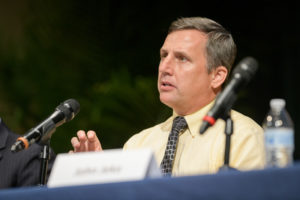
Data Science Institute Faculty Council member Louis Rossi is a professor and chair of the math department.
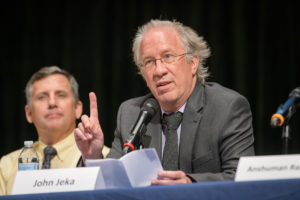
Data Science Institute Faculty Council member John Jeka is a professor and chair of the Department of Kinesiology and Applied Physiology.

